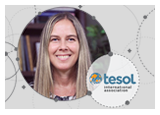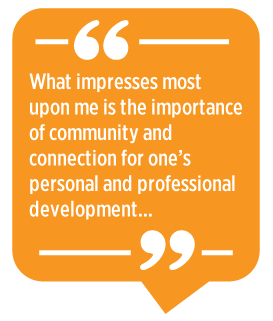
When I think back on how I got my start in TESOL, my memories are filled with images of a cohort of graduate students pursuing their MA in linguistics with a focus on second language acquisition and TESOL. We were a small cohort, responsible for teaching the academic English courses at the University of Utah. I can still vividly picture us sitting around tables in a small seminar room, casual and at ease with our mentors, Professors MaryAnn Christison and Adrian “Buzz” Palmer.
Throughout my MA and PhD programs at the U, I cherished these weekly meetings. Not only did we work as a community of practice designing activities and lessons, giving microteaching demonstrations, tweaking rubrics (oh, the rubrics!), grading writing placement tests, and grappling with classroom management issues, but we also became family. We spent time together socially outside of class; we knew each other’s families, including the furkids; we grieved one another’s losses and celebrated successes. To this day, many of us from this cohort are still in touch—but beyond being in touch, we are collaborators and coconspirators in the fields of TESOL and education. We have coauthored, coedited, and copresented on a range of topics spanning advocacy for international students in higher education, translingual practices in schools, the benefits of community-engaged learning, literacy education in multilingual contexts, the TESOL practicum, and so much more! We live in several different states and countries now, working as professors, researchers, and consultants, but our lineage traces back to that seminar room at the University of Utah. Reflecting on my TESOL journey, what impresses most upon me is the importance of community and connection for one’s personal and professional development, as well as one’s sense of belonging in the field.

My career in TESOL has included various positions: assistant professor in two MA TEFL/TESOL programs, at the American University of Armenia and St. Michael’s College; my current position as an associate teaching professor and director of the TESOL Program at the University of Colorado Boulder; EL specialist for the U.S. Department of State; and board member for Literacy Education and Second Language Learning for Adults, Colorado TESOL (CoTESOL), and now TESOL International Association. In each of these roles, what keeps me going is a strong sense of connection to others who share my values related to the power of education to change lives and who invest in making the world a better place for multilingual, multicultural individuals worldwide.
In my role as a teacher educator, I draw on the fond memories of time spent with my graduate student peers to cultivate community among my TESOL students. Like Drs. Christison and Palmer did with us, I relate to my students as if they were already colleagues in the field with much to share with the larger TESOL community. I am grateful for the courage instilled in us as graduate students to present at the TESOL International Convention & English Language Expo. Being able to contribute to the field in this way was exhilarating. We gained so much confidence from the positive feedback received at these professional meetings that we went back again and again, as one does! Years (and many presentations) later, I seek opportunities to leverage my students’ ideas and cultivate their enthusiasm for a future career in TESOL. I am giddy when encouraging students to submit proposals to regional and international conferences because I know the impact it can have on their belief in themselves as TESOL professionals.
Currently, I work mostly with undergraduate students, and it is that much more rewarding to see them find their voice and present as novices to professionals in the field. Last year, students from my Teaching L2 Oral Skills course presented on their open access curriculum design units, which target speaking, listening, and pronunciation through social justice themes. Four of them copresented on a panel with me at CoTESOL, while three others presented posters at the Society for Linguistic Anthropology conference. (See their social justice units here). This month, I copresented with four of my undergraduate TESOL students at the CoTESOL Fall Convention. We presented about a virtual exchange project my class engaged in with students in Indonesia and Russia. As a result of that presentation, we have a new potential partner in Tahiti, and have inspired a Colorado teacher of Slovak origin to launch a similar project between her English as an additional language students in Colorado and Slovak English learners at her high school in Slovakia! During our presentation, one of my students said that a surprising outcome of the virtual exchange project was the strengthening of community among the TESOL students as they met weekly to prepare for meetings with their international counterparts. Secretly, it is often a mini-mission of mine to ensure that my students forge genuine, lasting friendships in my courses. When I see them chatting and laughing before class and hear them talking about meet-ups out of class for a meal—that’s when I know I’ve been successful.
Teacher educators and mentors play an instrumental role in the personal and professional lives of TESOL students. It is our privilege to not only instill in them the knowledge, skills, and dispositions to be effective and ethical practitioners, but also to cultivate in them an appreciation for community and connection. If we can effectively model what building community and relationships looks like in our TESOL teacher education programs, then we are investing in the potential for our students to foster community among learners and colleagues they’ll work with in the future. As Margaret J. Wheatley (2009) said, “There is no power for change greater than a community discovering what it cares about” (p. 55). In a world where we are separated by screens, even as we sit side by side, I hope we can all find ways to foster genuine human connection that will sustain our students and ourselves as we navigate our complex, multifaceted, and purposeful lives.
I write this with love and gratitude for my first TESOL community: MAC, Buzz, Zuzana, Mara, Kristen, Ellen, Eleonore, Tamrika, Holly, Maren, Jade, Anna, Jelena, Olena, Karin, Karen, Xing, Hannah, and Amy.
Reference
Wheatley, M. J. (2009). Turning to one another: Simple conversations to restore hope to the future (2nd ed.). Berrett-Koehler.
|
Download this column (PDF) |
Raichle “Rai” Farrelly, PhD, is an associate teaching professor and director of the TESOL Program for the Department of Linguistics at the University of Colorado Boulder. She offers courses on a range of topics, including language teaching methods, teaching second language oral skills, pedagogical grammar, world language policy, the TESOL Practicum, and introduction to Linguistics. Her professional interests include second language teacher education, reflective teaching, curriculum design, community-engaged learning, and teaching refugee-background adults. Farrelly has presented extensively on a range of pedagogical topics at national and international conferences, including TESOL, IATEFL, LESLLA, and Africa TESOL. In addition to peer-reviewed articles and chapters, Farrelly coauthored the book Fostering International Student Success in Higher Education, coedited Educating Refugee-background Students: Critical Issues and Dynamic Contexts, and coedited the Handbook of Research on Cultivating Literacy in Diverse and Multilingual Classrooms.
| Next Article |
